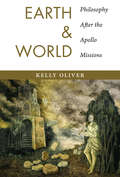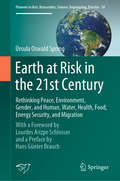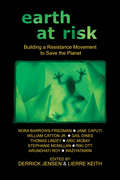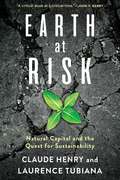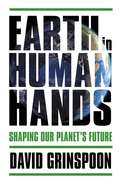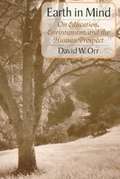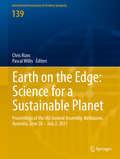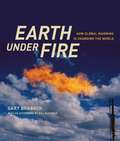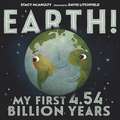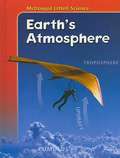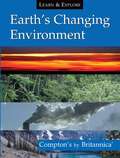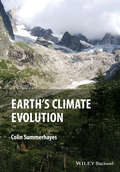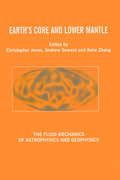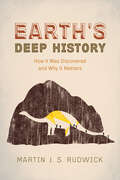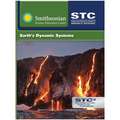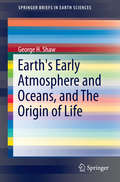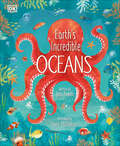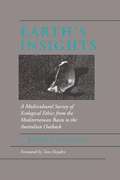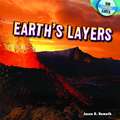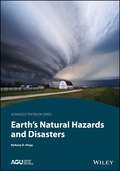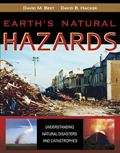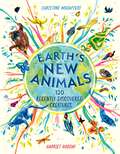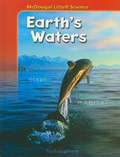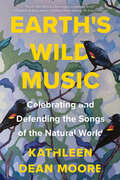- Table View
- List View
Earth and World: Philosophy After the Apollo Missions
by Kelly OliverCritically engaging the work of Immanuel Kant, Hannah Arendt, Martin Heidegger, and Jacques Derrida together with her own observations on contemporary politics, environmental degradation, and the pursuit of a just and sustainable world, Kelly Oliver lays the groundwork for a politics and ethics that embraces otherness without exploiting difference. Rooted firmly in human beings' relationship to the planet and to each other, Oliver shows peace is possible only if we maintain our ties to earth and world.Oliver begins with Immanuel Kant and his vision of politics grounded on earth as a finite surface shared by humans. She then incorporates Hannah Arendt's belief in plural worlds constituted through human relationships; Martin Heidegger's warning that alienation from the Earth endangers not only politics but also the very essence of being human; and Jacques Derrida's meditations on the singular worlds individuals, human and otherwise, create and how they inform the reality we inhabit. Each of these theorists, Oliver argues, resists the easy idealism of world citizenship and globalism, yet they all think about the earth against the globe to advance a grounded ethics. They contribute to a philosophy that avoids globalization's totalizing and homogenizing impulses and instead help build a framework for living within and among the world's rich biodiversity.
Earth at Risk in the 21st Century: With a Foreword by Lourdes Arizpe Schlosser and a Preface by Hans Günter Brauch (Pioneers in Arts, Humanities, Science, Engineering, Practice #18)
by Úrsula Oswald SpringEarth at Risk in the 21st Century offers critical interdisciplinary reflections on peace, security, gender relations, migration and the environment, all of which are threatened by climate change, with women and children affected most. Deep-rooted gender discrimination is also a result of the destructive exploitation of natural resources and the pollution of soils, water, biota and air. In the Anthropocene, the management of human society and global resources has become unsustainable and has created multiple conflicts by increasing survival threats primarily for poor people in the Global South. Alternative approaches to peace and security, focusing from bottom-up on an engendered peace with sustainability, may help society and the environment to be managed in the highly fragile natural conditions of a ‘hothouse Earth’. Thus, the book explores systemic alternatives based on indigenous wisdom, gift economy and the economy of solidarity, in which an alternative cosmovision fosters mutual care between humankind and nature.• Special analysis of risks to the survival of humankind in the 21st century.• Interdisciplinary studies on peace, security, gender and environment related to global environmental and climate change.• Critical reflections on gender relations, peace, security, migration and the environment• Systematic analysis of food, water, health, energy security and its nexus.• Alternative proposals from the Global South with indigenous wisdom for saving Mother Earth.
Earth at Risk: Building a Resistance Movement to Save the Planet (Flashpoint Press)
by Derrick JensenThe annual conference Earth at Risk: Building a Resistance Movement to Save the Planet features environmental thinkers and activists who are willing to ask the hardest questions about the seriousness of the planet's situation, and this book presents an impassioned critique of the dominant culture from every angle. Speakers from the conference are featured in this volume and include William Catton, who explains ecological overshoot; Thomas Linzey, who gives a fiery call for community sovereignty; Jane Caputi, who exposes patriarchy's mythic dismemberment of the goddess; Aric McBay, who discusses historically effective resistance strategies; and Stephanie McMillan, who takes down capitalism. One by one, they build an unassailable case that the rich should be deprived of their ability to steal from the poor and the powerful of their ability to destroy the planet. These speakers offer their ideas on what can be done to build a real resistance movement: one that includes all levels of direct action that can actually match the scale of the problem. Also included are the speakers Derrick Jensen, Arundhati Roy, Rikki Ott, Gail Dines, Waziyatawin, Lierre Keith, and Nora Barrows-Friedman.
Earth at Risk: Natural Capital and the Quest for Sustainability
by Laurence Tubiana Claude HenryWe are squandering our planet’s natural capital—its biodiversity, water and soil, and climate stability—at a blistering pace. Major changes must be made to steer our planet and people away from our current, doomed course. Though technology has been one of the drivers of the current trend of unsustainable development, it is also one of the essential tools for remedying it. Earth at Risk maps out the necessary transition to sustainability, detailing the innovations in science and technology, along with law, institutional design, and economics, that can and must be put to use to avert environmental catastrophe.Claude Henry and Laurence Tubiana begin with a measure of the costs of ecological damage—the erosion of biodiversity; air, water, and soil pollution; and the wide-reaching effects of climate change—and then consider the solutions that are either now available or close on the horizon and that may lead to a more sustainable global trajectory. What community-driven or market-based tools can be used to promote sustainable development? How can renewable energy and energy storage advances help us decrease our use of fossil fuels? How can we substitute agroecology for the damaging chemical methods of industrialized agriculture? Is international agreement on climate goals possible? Building on the experience of the most significant climate negotiation of the decade, Earth at Risk shows what a world organized along the principles of sustainability could look like, no matter how optimistic it may seem at the present moment. Though formidable obstacles remain to the realization of this significant transition, Henry and Tubiana present the case for collective initiatives and change that build momentum for implementation and action.
Earth in Human Hands: Shaping Our Planet's Future
by David GrinspoonFor the first time in Earth's history, our planet is experiencing a confluence of rapidly accelerating changes prompted by one species: humans. Climate change is only the most visible of the modifications we've made--up until this point, inadvertently--to the planet. And our current behavior threatens not only our own future but that of countless other creatures. By comparing Earth's story to those of other planets, astrobiologist David Grinspoon shows what a strange and novel development it is for a species to evolve to build machines, and ultimately, global societies with world-shaping influence. Without minimizing the challenges of the next century, Grinspoon suggests that our present moment is not only one of peril, but also great potential, especially when viewed from a 10,000-year perspective. Our species has surmounted the threat of extinction before, thanks to our innate ingenuity and ability to adapt, and there's every reason to believe we can do so again. Our challenge now is to awaken to our role as a force of planetary change, and to grow into this task. We must become graceful planetary engineers, conscious shapers of our environment and caretakers of Earth's biosphere. This is a perspective that begs us to ask not just what future do we want to avoid, but what do we seek to build? What kind of world do we want? Are humans the worst thing or the best thing to ever happen to our planet? Today we stand at a pivotal juncture, and the answer will depend on the choices we make.
Earth in Mind: On Education, Environment, and the Human Prospect
by David W. OrrOrr (environmental studies and politics, Oberlin College) presents the tenth anniversary edition of his text addressing educational reform from an environmental perspective. In a collection of 23 essays, written for various purposes and audiences between 1990 and 1993, Orr argues that, where educational debates about standards and reforms have centered around preparing students to compete in a global economy, an equally important concern should be teaching students the ecological context in which humans live, to develop in them an ethical view of the world and their obligations to it. The tenth edition includes a brief new introduction and a new final chapter offering "hope in hard times. " Annotation ©2004 Book News, Inc. , Portland, OR (booknews. com)
Earth on the Edge: Science for a Sustainable Planet
by Chris Rizos Pascal WillisThis book series is composed of peer-reviewed proceedings of selected symposia organized by the International Association of Geodesy. It deals primarily with topics related to Geodesy Earth Sciences : terrestrial reference frame, Earth gravity field, Geodynamics and Earth rotation, Positioning and engineering applications.
Earth under Fire: How Global Warming Is Changing the World
by Gary BraashEarth under Fire is the most complete guide to the effects of climate change now available. It offers an upbeat and intelligent account of how we can lessen the effects of our near-total dependence on fossil fuels using technologies and energy sources already available.
Earth! My First 4.54 Billion Years (Our Universe #1)
by Stacy McAnultyA lighthearted nonfiction picture book about the formation and history of the Earth--told from the perspective of the Earth itself!"Hi, I’m Earth! But you can call me Planet Awesome." Prepare to learn all about Earth from the point-of-view of Earth herself! In this funny yet informative book, filled to the brim with kid-friendly facts, readers will discover key moments in Earth’s life, from her childhood more than four billion years ago all the way up to present day. Beloved children's book author Stacy McAnulty helps Earth tell her story, and award-winning illustrator David Litchfield brings the words to life. The book includes back matter with even more interesting tidbits.This title has Common Core connections.
Earth's Changing Environment
by Encyclopaedia BritannicaThe examination of the causes and effects of climate change on the environment is adapted from articles to be included in current and upcoming editions of Compton's Encyclopedia. Climate, ecology, and environmental pollution are the main subjects with each area subdivided into sections including the greenhouse effect, biogeography, endangered species, and environmentalism.
Earth's Climate Evolution
by C. P. SummerhayesTo understand climate change today, we first need to know how Earth’s climate changed over the past 450 million years. Finding answers depends upon contributions from a wide range of sciences, not just the rock record uncovered by geologists. In Earth’s Climate Evolution, Colin Summerhayes analyzes reports and records of past climate change dating back to the late 18th century to uncover key patterns in the climate system. The book will transform debate and set the agenda for the next generation of thought about future climate change. The book takes a unique approach to the subject providing a description of the greenhouse and icehouse worlds of the past 450 million years since land plants emerged, ignoring major earlier glaciations like that of Snowball Earth, which occurred around 600 million years ago in a world free of land plants. It describes the evolution of thinking in palaeoclimatology and introduces the main players in the field and how their ideas were received and, in many cases, subsequently modified. It records the arguments and discussions about the merits of different ideas along the way. It also includes several notes made from the author’s own personal involvement in palaeoclimatological and palaeoceanographic studies, and from his experience of working alongside several of the major players in these fields in recent years. This book will be an invaluable reference for both undergraduate and postgraduate students taking courses in related fields and will also be of interest to historians of science and/or geology, climatology and oceanography. It should also be of interest to the wider scientific and engineering community, high school science students, policy makers, and environmental NGOs.Reviews:"Outstanding in its presentation of the facts and a good read in the way that it intersperses the climate story with the author's own experiences. [This book] puts the climate story into a compelling geological history." -Dr. James Baker "The book is written in very clear and concise prose, [and takes] original, enlightening, and engaging approach to talking about 'ideas' from the perspective of the scientists who promoted them." -Professor Christopher R. Scotese"A thrilling ride through continental drift and its consequences."- Professor Gerald R. North"Written in a style and language which can be easily understood by laymen as well as scientists."- Professor Dr Jörn Thiede"What makes this book particularly distinctive is how well it builds in the narrative of change in ideas over time."- Holocene book reviews, May 2016"This is a fascinating book and the author’s biographical approach gives it great human appeal." - E Adlard
Earth's Climate: Past and Future
by William F. RuddimanAt a time when the evidence is stronger than ever that human activity is the primary cause for global climate change, William Ruddiman's breakthrough text returns in a thoroughly updated new edition. It offers a clear, engaging, objective portrait of the current state of climate science, including compelling recent findings on anthropogenic global warming and important advances in understanding past climates.
Earth's Core and Lower Mantle (The Fluid Mechanics of Astrophysics and Geophysics)
by Christopher A. Jones Keke Zhang Andrew M. SowardScientists have made new inroads in the study of the Earth's deep interior. They have forged developments in this fascinating arena using experimental and observational techniques,. including seismology, monitoring of the Earth's rotation, geomagnetism, and accurate measurements of Earth's gravity fields. These techniques along with more theoretica
Earth's Deep History: How It Was Discovered and Why It Matters
by Martin J. RudwickEarth has been witness to mammoths and dinosaurs, global ice ages, continents colliding or splitting apart, comets and asteroids crashing catastrophically to the surface, as well as the birth of humans who are curious to understand it all. But how was it discovered? How was the evidence for it collected and interpreted? And what kinds of people have sought to reconstruct this past that no human witnessed or recorded? In this sweeping and magisterial book, Martin J. S. Rudwick, the premier historian of the earth sciences, tells the gripping human story of the gradual realization that the Earth's history has not only been unimaginably long but also astonishingly eventful. Rudwick begins in the seventeenth century with Archbishop James Ussher, who famously dated the creation of the cosmos to 4004 BC. His narrative then turns to the crucial period of the late eighteenth and early nineteenth centuries, when inquisitive intellectuals, who came to call themselves "geologists," began to interpret rocks and fossils, mountains and volcanoes, as natural archives of Earth's history. He then shows how this geological evidence was used--and is still being used--to reconstruct a history of the Earth that is as varied and unpredictable as human history itself. Along the way, Rudwick defies the popular view of this story as a conflict between science and religion and reveals that the modern scientific account of the Earth's deep history retains strong roots in Judaeo-Christian ideas. Extensively illustrated, Earth's Deep History is an engaging and impressive capstone to Rudwick's distinguished career. Though the story of the Earth is inconceivable in length, Rudwick moves with grace from the earliest imaginings of our planet's deep past to today's scientific discoveries, proving that this is a tale at once timeless and timely.
Earth's Dynamic Systems: Student Guide
by Carolina Biological Supply CompanyGrades 6–8. This hardbound Student Guide and Source Book provides the student investigations, student goals and objectives, and reading selections for the Earth's Dynamic Systems unit.
Earth's Early Atmosphere and Oceans, and The Origin of Life
by George H. ShawThis book provides a comprehensive treatment of the chemical nature of the Earth's early surface environment and how that led to the origin of life. This includes a detailed discussion of the likely process by which life emerged using as much quantitative information as possible. The emergence of life and the prior surface conditions of the Earth have implications for the evolution of Earth's surface environment over the following 2-2. 5 billion years. The last part of the book discusses how these changes took place and the evidence from the geologic record that supports this particular version of early and evolving conditions.
Earth's Incredible Oceans (The Magic and Mystery of the Natural World)
by Jess FrenchEnter the world of oceans and discover all the interesting animals that live in them!Swim with jellyfish, wonder at the busy life of a seagrass meadow, and fence with narwhals in this lovingly illustrated children&’s book. Take kids on a fascinating underwater journey, showing them just how amazing oceans are, what plants and animals live in them, and how we can help themInside the pages of this kids ocean book, you&’ll discover: • Interesting information about oceans that supports and goes beyond the curriculum • Fun and unusual facts to convey the amazing world of ocean life • Detailed illustrations and photographs of fish, shellfish, mammals such as dolphins, waves, and more Explore a world hidden below the wavesLet's go on an underwater adventure! From glowing jellyfish to deep-sea dwellers, children will discover the incredible secret world of life under the sea. This ocean book is filled with a combination of gorgeous photographs and colorful illustrations that will delight and inspire kids - teaching them the importance of the ocean and how to help take care of it themselves.Little ones will be intrigued by sea life like sharks, narwhals, sea birds, ocean reptiles, and so much more. They will learn interesting facts, and explanations about how the ocean functions, like how underwater plants and species rely on each other, and how ocean animals have fun and look after their young. This beautiful book is the perfect gift for young animal and conservation enthusiasts.More children&’s nature titles to discover DK's Kid&’s Nature series is a series of educational books for kids that teach them about the magical natural world. Other books in this series include The Magic and Mystery of Trees and The Book of Brilliant Bugs.
Earth's Insights: A Multicultural Survey of Ecological Ethics from the Mediterranean Basin to the Australian Outback
by J. Baird CallicottAlthough environmental crisis is global in scope, contemporary environmental ethics is centered predominantly in Western philosophy and religion. EARTH'S INSIGHTS widens the scope to include the ecological teachings embedded in non-Western world views. Conservationist J. Baird Callicott asks how the world's diverse environmental philosophies can be brought together to benefit the whole.
Earth's Layers
by Jason D. NemethAs Earth's inhabitants, we are pretty familiar with what the planet's surface looks like, but we seldom get a chance to look beneath Earth's crust. This captivating book takes a closer look at Earth's layers from crust to core. The volume discusses how Earth's layers contribute to the formation of its magnetic field and help fuel volcanic activity. Readers will learn the story of Earth's formation and come away knowing whether the planet's core is now growing warmer or cooling off. Fun photographs, useful diagrams, and age-appropriate language make these complex topics comprehensible to the book's lower-elementary audience.
Earth's Natural Hazards and Disasters (AGU Advanced Textbooks)
by Bethany D. HingaNatural hazards are present in every part of planet Earth. Sometimes a natural event – such as extreme weather, a volcanic eruption, earthquake or disease outbreak – turns into a disaster for humans, the environment, and the economy. Earth’s Natural Hazards and Disasters is a textbook for undergraduates that challenges students to think critically about disasters. It explains the science behind natural events and explores how to understand risk and prepare for disasters. About this volume: Covers hazards in the geosphere, hydrosphere, atmosphere, and biosphere Explains the science of hazards in accessible terms Detailed case studies of specific disasters for each type of natural event Explores data-based risk mitigation strategies Discusses the roles of scientists, public officials, and the general public in hazard management The American Geophysical Union promotes discovery in Earth and space science for the benefit of humanity. Its publications disseminate scientific knowledge and provide resources for researchers, students, and professionals.
Earth's Natural Hazards: Understanding Natural Disasters And Catastrophes
by David M. Best David B. HackerChances are that students remember at least one major geologic disatter that has happened in their lifetime. This textbook will help them understand the background of these life-changing events.
Earth's New Animals: 120 Recently Discovered Creatures
by Christine ModafferiExplorers and scientists are discovering up to a thousand new animal species every year and estimate that over 7.5 MILLION species are yet to be discovered. So, without further ado, let's meet Earth's new animals!From newly recorded species of whale and grasshopper-warbler to beautiful rose-veiled fairy wrasse and teeny-tiny chameleons, travel the natural world and find out all about the fascinating new species of animal that are only just being discovered. Read all about their habitats and the remarkable stories of how they were found, and learn NEW things about animals we thought we already knew...Written by children's book author Christine Modafferi, with beautiful illustrations by Harriet Hobday, this glorious new take on natural history will delight and fascinate young animal lovers aged 6+. Perfect for animal-loving and planet-protecting families.
Earth's Wild Music: Celebrating and Defending the Songs of the Natural World
by Kathleen Dean MooreAt once joyous and somber, this thoughtful gathering of new and selected essays spans Kathleen Dean Moore's distinguished career as a tireless advocate for environmental activism in the face of climate change. In this meditation on the music of the natural world, Moore celebrates the call of loons, howl of wolves, bellow of whales, laughter of children, and shriek of frogs, even as she warns of the threats against them. Each group of essays moves, as Moore herself has been moved, from celebration to lamentation to bewilderment and finally to the determination to act in defense of wild songs and the creatures who sing them. Music is the shivering urgency and exuberance of life ongoing. In a time of terrible silencing, Moore asks, who will forgive us if we do not save nature's songs?
